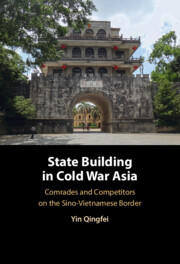Book contents
- Frontmatter
- Contents
- Figures
- Maps
- Acknowledgments
- Notes on Romanization, Names, and Pseudonymization
- Abbreviations
- Introduction
- 1 Asymmetric State Building (1949–1954)
- 2 Joint State Building (1954–1957)
- 3 Negotiated State Building (1958–1964)
- 4 Thwarted State Building on the Sea (1954–1964)
- 5 Reversed State Building (1965–1975)
- Conclusion
- Bibliography
- Index
Introduction
Internationalism, Nationalism, and Transnational Localism at the Sino-Vietnamese Border
Published online by Cambridge University Press: 18 December 2024
- Frontmatter
- Contents
- Figures
- Maps
- Acknowledgments
- Notes on Romanization, Names, and Pseudonymization
- Abbreviations
- Introduction
- 1 Asymmetric State Building (1949–1954)
- 2 Joint State Building (1954–1957)
- 3 Negotiated State Building (1958–1964)
- 4 Thwarted State Building on the Sea (1954–1964)
- 5 Reversed State Building (1965–1975)
- Conclusion
- Bibliography
- Index
Summary
Departing from the conventional narrative that views borders exclusively as a source of hostility in inter-Asian relations, this book tells a story of how two revolutionary states launched movements and pursued policies that echoed each other as well as collaborated in extending their authority to the border to temper the transnational tendencies there – a process that the author characterizes as “joint state invasion,” which challenges both the Scottian narrative of state evasion and the Tillyan model of state formation. The Guangxi-northeastern Vietnam border is geographically, economically, and ethnically diverse and includes highlands, lowlands, and access to the Gulf of Tonkin. State activities at the border in the second half of the twentieth century were initiated in the context of historical precedents of successful, and equally importantly, unsuccessful state intrusions into the borderlands. There was a qualitative difference between state activities on the Sino-Vietnamese border that began during the Cold War and those that came before, where “distracted states” facing continuous wars were often unable to devote adequate resources to the task of border making. More importantly, limited coordination between the successive Chinese governments and the French colonial state left the border people significant “wiggle room” to circumvent the political authority.
Keywords
- Type
- Chapter
- Information
- State Building in Cold War AsiaComrades and Competitors on the Sino-Vietnamese Border, pp. 1 - 35Publisher: Cambridge University PressPrint publication year: 2024

